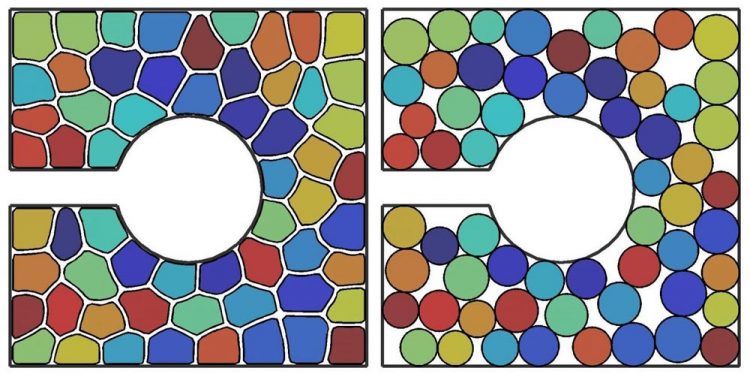CCNY-Yale researchers make shape shifting cell breakthrough

Deformable particles like cells can fill complex geometries more efficiently than fixed shapes like circles. With the new deformable particle model introduced by Shattuck and O'Hern, researchers can also simulate deformable systems more efficiently and accurately. Credit: Mark Shattuck, CCNY
Mark D. Shattuck, professor of physics at City College's Benjamin Levich Institute, and researchers at Yale developed the new efficient computational model. It allows simulated particles to realistically change shape while conserving volume during interactions with other particles. Their results appear in the latest edition of Physical Review Letters.
Developing computer simulations of particles, such as sand grains and ball bearings, is straightforward because they do not readily change shape. Doing the same for cells and other deformable particles is more difficult, and the computational models researchers currently use do not accurately capture how soft particles deform.
The computational model developed by Shattuck and lead investigator from Yale, Corey O'Hern, tracks points on the surfaces of polygonal cells. Each surface point moves independently, in accordance with its surroundings and neighboring particles, allowing the shape of the particle to change. It is more computationally demanding than current simulations, but necessary to correctly model particle deformation.
“We now have an efficient accurate computational model to investigate how discrete, deformable particles pack,” Shattuck said. It also allows researchers to easily adjust cell-cell interactions, consider directed motion, and can be used for both 2D and 3D systems.
One unexpected result from the model shows that deformable particles must deviate from a sphere by more than 15% to completely fill a space.
“In our new model, if no external pressure is applied to the system, the particles are spherical,” O'Hern said. “As the pressure is increased, the particles deform, increasing the fraction of space that they occupy. When the particles completely fill the space, they will be 15% deformed. Whether it's bubbles, droplets, or cells, it's a universal result for soft, particle systems.”
Among other applications, this technology may give researchers a new tool to examine how cancerous tumors metastasize. “We can now create realistic models of the packing of cells in tumors using computer simulations, and ask important questions such as whether a cell in a tumor needs to change its shape to become more capable of motion and eventually leave the tumor.”
Media Contact
All latest news from the category: Physics and Astronomy
This area deals with the fundamental laws and building blocks of nature and how they interact, the properties and the behavior of matter, and research into space and time and their structures.
innovations-report provides in-depth reports and articles on subjects such as astrophysics, laser technologies, nuclear, quantum, particle and solid-state physics, nanotechnologies, planetary research and findings (Mars, Venus) and developments related to the Hubble Telescope.
Newest articles

Can lab-grown neurons exhibit plasticity?
“Neurons that fire together, wire together” describes the neural plasticity seen in human brains, but neurons grown in a dish don’t seem to follow these rules. Neurons that are cultured…

Unlocking the journey of gold through magmatic fluids
By studying sulphur in magmatic fluids at extreme pressures and temperatures, a UNIGE team is revolutionising our understanding of gold transport and ore deposit formation. When one tectonic plate sinks…

3D concrete printing method that captures carbon dioxide
Scientists at Nanyang Technological University, Singapore (NTU Singapore) have developed a 3D concrete printing method that captures carbon, demonstrating a new pathway to reduce the environmental impact of the construction…



